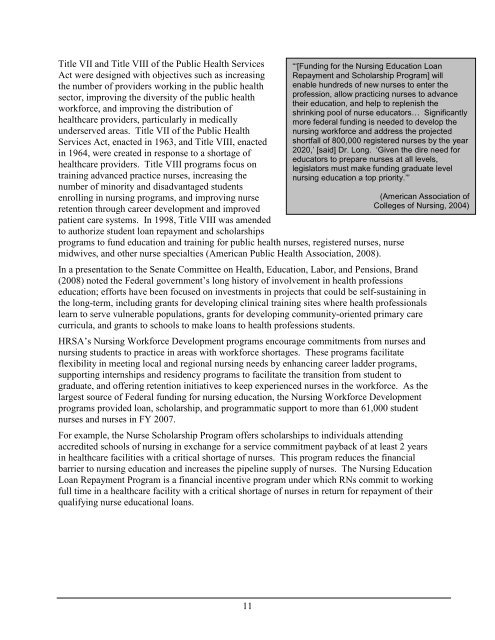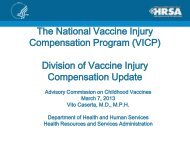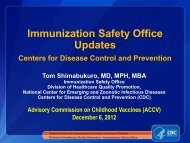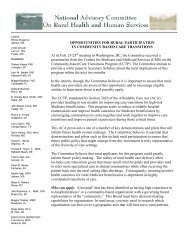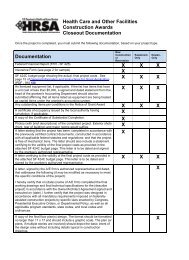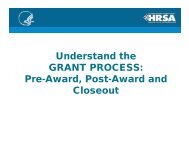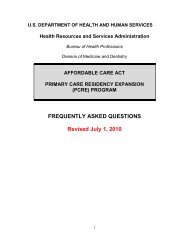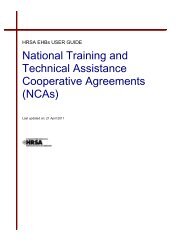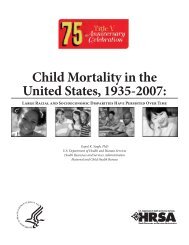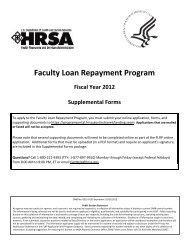Addressing New Challenges Facing Nursing Education ... - HRSA
Addressing New Challenges Facing Nursing Education ... - HRSA
Addressing New Challenges Facing Nursing Education ... - HRSA
Create successful ePaper yourself
Turn your PDF publications into a flip-book with our unique Google optimized e-Paper software.
Title VII and Title VIII of the Public Health Services<br />
Act were designed with objectives such as increasing<br />
the number of providers working in the public health<br />
sector, improving the diversity of the public health<br />
workforce, and improving the distribution of<br />
healthcare providers, particularly in medically<br />
underserved areas. Title VII of the Public Health<br />
Services Act, enacted in 1963, and Title VIII, enacted<br />
in 1964, were created in response to a shortage of<br />
healthcare providers. Title VIII programs focus on<br />
training advanced practice nurses, increasing the<br />
number of minority and disadvantaged students<br />
enrolling in nursing programs, and improving nurse<br />
retention through career development and improved<br />
patient care systems. In 1998, Title VIII was amended<br />
to authorize student loan repayment and scholarships<br />
programs to fund education and training for public health nurses, registered nurses, nurse<br />
midwives, and other nurse specialties (American Public Health Association, 2008).<br />
In a presentation to the Senate Committee on Health, <strong>Education</strong>, Labor, and Pensions, Brand<br />
(2008) noted the Federal government’s long history of involvement in health professions<br />
education; efforts have been focused on investments in projects that could be self-sustaining in<br />
the long-term, including grants for developing clinical training sites where health professionals<br />
learn to serve vulnerable populations, grants for developing community-oriented primary care<br />
curricula, and grants to schools to make loans to health professions students.<br />
<strong>HRSA</strong>’s <strong>Nursing</strong> Workforce Development programs encourage commitments from nurses and<br />
nursing students to practice in areas with workforce shortages. These programs facilitate<br />
flexibility in meeting local and regional nursing needs by enhancing career ladder programs,<br />
supporting internships and residency programs to facilitate the transition from student to<br />
graduate, and offering retention initiatives to keep experienced nurses in the workforce. As the<br />
largest source of Federal funding for nursing education, the <strong>Nursing</strong> Workforce Development<br />
programs provided loan, scholarship, and programmatic support to more than 61,000 student<br />
nurses and nurses in FY 2007.<br />
For example, the Nurse Scholarship Program offers scholarships to individuals attending<br />
accredited schools of nursing in exchange for a service commitment payback of at least 2 years<br />
in healthcare facilities with a critical shortage of nurses. This program reduces the financial<br />
barrier to nursing education and increases the pipeline supply of nurses. The <strong>Nursing</strong> <strong>Education</strong><br />
Loan Repayment Program is a financial incentive program under which RNs commit to working<br />
full time in a healthcare facility with a critical shortage of nurses in return for repayment of their<br />
qualifying nurse educational loans.<br />
11<br />
“‘[Funding for the <strong>Nursing</strong> <strong>Education</strong> Loan<br />
Repayment and Scholarship Program] will<br />
enable hundreds of new nurses to enter the<br />
profession, allow practicing nurses to advance<br />
their education, and help to replenish the<br />
shrinking pool of nurse educators… Significantly<br />
more federal funding is needed to develop the<br />
nursing workforce and address the projected<br />
shortfall of 800,000 registered nurses by the year<br />
2020,’ [said] Dr. Long. ‘Given the dire need for<br />
educators to prepare nurses at all levels,<br />
legislators must make funding graduate level<br />
nursing education a top priority.’”<br />
(American Association of<br />
Colleges of <strong>Nursing</strong>, 2004)


